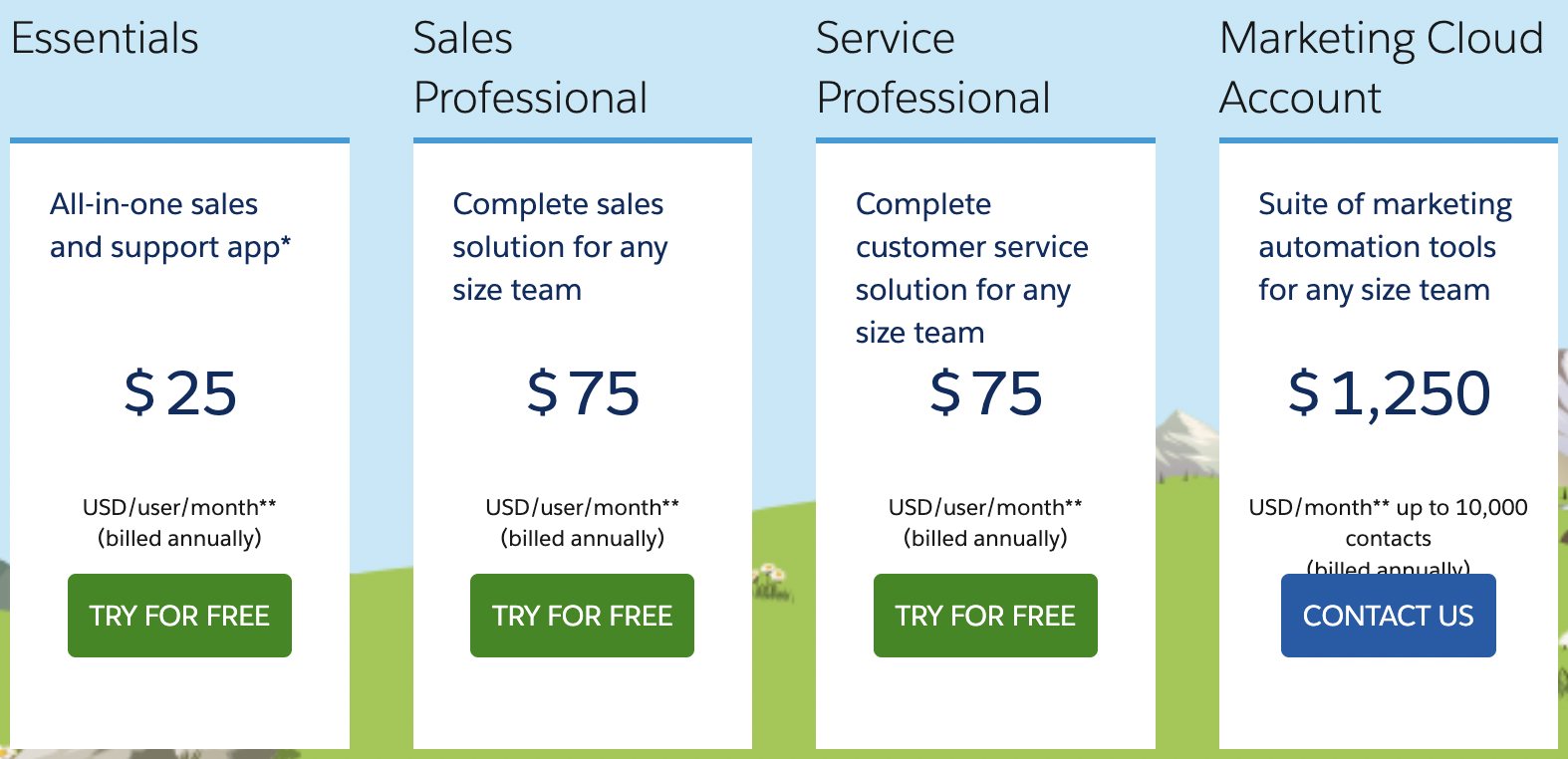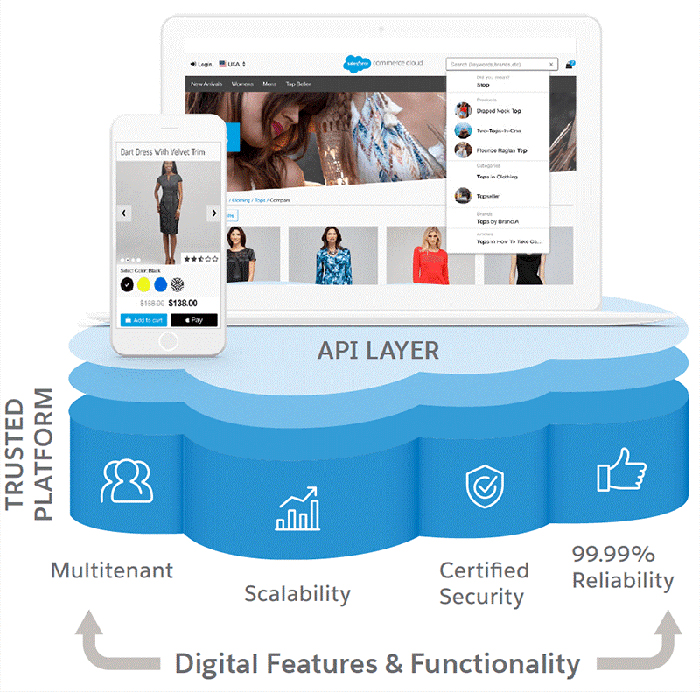The world of e-Commerce is constantly evolving, and companies are always looking for ways to improve the online shopping experience for their customers. One trend that has gained significant traction in recent years is the move from monolithic e-Commerce platforms to headless commerce solutions.
For organizations using Storefront Reference Architecture (SFRA), this has led to increased interest in Salesforce Commerce Cloud SFRA migration.
In this blog, we will explore the key benefits of this migration, the migration process and why it may be worth considering for your organization.
- SFRA is used with Salesforce by multinational companies like Adidas to make their website feel faster due to their huge sales on product launches.
- Salesforce generated around 17 billion US dollars in the fiscal year 2022, becoming one of the most revenue-generated e-Commerce companies.
- Salesforce has around 150 thousand medium to large businesses registered on it with clientele, including Amazon, Walmart, OLX, and many more.
What Is SFRA?
SFRA (Storefront Reference Architecture) is a platform for building and managing e-commerce websites on the Salesforce commerce cloud optimization platform. It provides a set of tools and components for building and customizing e-commerce experiences, including a library of pre-built UI components, salesforce b2b commerce cloud partner, and salesforce certified b2c commerce developer support for responsive design and multi-language websites.
SFRA also provides a number of features to help organizations manage their e-commerce websites, such as page templates, content management tools, and security and performance enhancements.
With SFRA, organizations can create e-commerce experiences that are tailored to their specific needs and requirements while taking advantage of the robust features and capabilities of the Salesforce platform.
Determining Factors for Salesforce Commerce Cloud SFRA Migration
The decision regarding whether or not to migrate from Storefront Reference Architecture (SFRA) to Salesforce Commerce Cloud will be influenced by a number of factors, including the following:
Business Needs
When deciding whether or not it is necessary for an organization to migrate from storefront Reference Architecture (SFRA) to Salesforce Headless Commerce, one of the most important factors to consider is the organization’s unique needs and requirements. Considerations may include
- The requirement for more advanced functionality such as personalization, omnichannel support, and improved analytics;
- Increased flexibility in customization and integration options;
- Improved user experience;
- Better scalability; and
- Enhanced security.
Capabilities In The Technical Area
When deciding whether or not to migrate to Salesforce Headless Commerce, another important factor to consider is an organization’s existing technical capabilities. This may include considerations such as the current condition of any existing systems, the availability of skilled technical resources, and the level of technical expertise needed to implement and maintain a headless commerce solution successfully.
Before deciding whether or not to migrate, organizations should carefully evaluate their technical capabilities to ensure that they have the resources and expertise necessary to implement and support a headless commerce solution successfully. This should be done before deciding whether or not to migrate.
Price And Spending Plan
When determining whether or not to migrate from SFRA to Salesforce Headless Commerce, important considerations to take into account include an organization’s costs as well as its budgetary constraints.
It is possible that a headless commerce solution will require a significant financial investment in order to cover the costs of its development and Salesforce Commerce Cloud Implementation, in addition to the ongoing costs of its maintenance and support. Before making a choice, businesses should conduct a thorough analysis of their finances, including their budget, as well as a cost-benefit analysis of migrating.
In the end, the choice of whether or not to migrate from SFRA to Salesforce Headless Commerce will be determined by a thorough assessment of the potential benefits and drawbacks of Salesforce Commerce Cloud Migration, in addition to a careful evaluation of the organization’s particular needs and requirements. This evaluation will be based on the organization’s specific needs and requirements.
Why Should You Migrate From SFRA to Salesforce and Not Some other Headless Commerce
Following are the reasons for you to migrate from SFRA to Salesforce Headless Commerce:
Personalized Shopping Experiences
By drawing on the information and insights provided by other Salesforce products, such as Marketing Cloud, Service Cloud, and Sales Cloud, merchants using Salesforce headless architecture are able to provide their customers with a more personalized shopping experience.
This makes it easier for merchants to understand the preferences of their customers and to cater the shopping experience to the specific requirements of each shopper.
Seamless Integration With Salesforce
Merchants are able to manage the entirety of their customer experience from within a single platform thanks to the integration capabilities of Salesforce with other Salesforce products while maintaining the headless commerce functionalities.
Access to information from all over the Salesforce ecosystem, such as customer data, order history, and other details, is included here. This can assist merchants in streamlining their processes, decreasing the number of data silos that exist, and improving the overall customer experience.
B2B And B2C Support
Merchants are able to sell their products to both individual consumers and business customers by utilizing Salesforce’s headless commerce qualities to support both business-to-business and business-to-consumer commerce. This makes it possible for business owners to serve a greater variety of customers and enter new markets.
Multi-channel Support
The web, mobile devices, and even in-person transactions are just some of the different sales channels that are supported by Salesforce Cloud Commerce. This makes it easier for businesses to connect with customers no matter where they are and offers a unified experience across different channels.
Product Information Management
By providing a centralized location for managing product information and pricing, Salesforce Cloud Commerce makes it simpler for merchants to keep the information about their products up to date and consistent across all of their various sales channels. Because of this, retailers will have a better chance of avoiding data inconsistencies and improving the accuracy of the product information they provide.
Order Management
Cloud Commerce from Salesforce offers powerful order management capabilities, such as processing, tracking, and fulfilling customer orders. This can make it easier for merchants to manage the orders they receive and provide better visibility into the various stages of the order lifecycle.
Payment and shipping options
Customers have come to expect a certain level of adaptability and convenience from the e-commerce platforms they use, and Salesforce Cloud Commerce provides that for merchants in the form of support for multiple payment and shipping options.
This has the potential to improve the overall shopping experience for customers while also assisting merchants in catering to the requirements of a wider variety of customers.
Step-By-Step Guide To Salesforce Commerce Cloud SFRA Migration
Here is a step-by-step guide to migrating from SFRA to Salesforce Headless Commerce:
Creating A Workflow Structure Plan
Workflow Structure defines how your site’s UI is going to work from the customer end. Now, since we are opting for migration, you have to adapt the workflow structure of your old website to the new architecture. So that the migration looks seamless from the front end.
The following image shows a structural workflow comparison of legacy and SFRA with Commerce cloud API. Basically, it shows the implementation of workflows in both architectures.
Choose A Salesforce Headless Commerce Subscription
Once you have determined that Salesforce’s headless commerce solution is a good fit, choose a subscription that meets your needs and requirements.
Plan Your Migration
Develop a detailed plan for your migration from SFRA to Salesforce Headless Commerce, including timelines, resources required, and key milestones. The plan is necessary as it will be the blueprint on which your development will take place.
Start The Migration
The Salesforce Commerce Cloud SFRA migration is only possible by a Salesforce Commerce Cloud development company or a Salesforce developer, as it is the migration of architecture to your site’s design. If you try to do it yourself, then there is a high chance that you will end up with some errors.
Begin the migration process, following your plan and making adjustments as needed. This may involve migrating data, re-architecting your front end, and integrating with your chosen headless commerce solution.
We suggest you opt for a Salesforce commerce cloud consultant for a perfect company and developer for your project.
Test And Validate
After the whole migration and development process is done, now it is your task to thoroughly test and validate your new headless commerce solution to ensure that it meets your needs and requirements. This may involve performance testing, security testing, and user acceptance testing.
Launch And Support
Launch your new headless commerce solution, and make sure to get ongoing Salesforce Commerce Cloud Support and maintenance to ensure that it continues to meet your needs and requirements.
It is important to note that Salesforce commerce cloud SFRA migration can be a complex and time-consuming process and may require significant investment in terms of development and implementation costs. As such, it is important to carefully evaluate your needs and requirements and work with a trusted partner to ensure a successful migration.
Benefits of Salesforce Commerce Cloud SFRA Migration
Following is the list of the benefits of a successful Salesforce Commerce Cloud SFRA migration:
Improved Customer Experience
Customers are able to have a shopping experience that is unified and personalized thanks to Salesforce Commerce Cloud. This gives customers the ability to easily find what they are looking for and quickly complete their transactions. This has the potential to help businesses increase the level of engagement and loyalty from their customers.
Increased Sales
Product recommendations, upselling, and cross-selling are just some of the advanced features that are available through Salesforce Commerce Cloud. These features suggest relevant products to customers based on data collected from their previous purchases, browsing behavior, and preferences in order to drive sales.
Improved Marketing Capabilities
The Salesforce Commerce Cloud provides advanced marketing capabilities such as segmenting customers and providing targeted promotions and email marketing, among other options. These features make it possible for businesses to customize their marketing efforts and communicate with customers by sending them relevant messages and providing them with relevant offers.
Improved Analytical Capabilities
Businesses are able to gain valuable insights into their customers, products, and operations with the help of Salesforce Commerce Cloud’s advanced analytics and reporting capabilities. This includes the ability to create individualized dashboards and reports, as well as real-time reporting on key metrics such as sales, traffic, and conversion rates.
Seamless Integration
Other Salesforce solutions, such as Salesforce Service Cloud and Salesforce Marketing Cloud, can be easily integrated with Salesforce Commerce Cloud without any complications. Because of this integration, companies are now able to connect data about their customers that are held in various parts of their businesses, thereby providing a more comprehensive portrait of their clientele.
Scalability
The Salesforce Commerce Cloud was developed to scale along with the growth of an organization, giving it the capacity to manage increasing volumes of traffic and transactions. This makes it easier for businesses to keep up with the demand and continue operating at a high level of performance even as their company expands.
Flexibility
Because it is highly modifiable, Salesforce Commerce Cloud gives businesses the ability to tailor the platform to the particular demands and necessities of their operations. This includes the capability to add bespoke functionality, integrate with the solutions provided by third parties, and produce individualized experiences for individual customers.
Wrap Up
Now you know how to go around scaling your store worldwide and make it able to handle the traffic.
Salesforce commerce cloud SFRA migration is highly useful for businesses with a need for high data packet transfers, traffic, and web load. This could mean faster responsiveness on your site improving your conversions as well.
Whether you were looking to improve your customers’ shopping experience, increase your flexibility and customization options, or keep up with the latest trends in e-commerce, this blog has provided valuable insights into the world of headless commerce and why Salesforce Commerce Cloud SFRA migration may be right for you.







